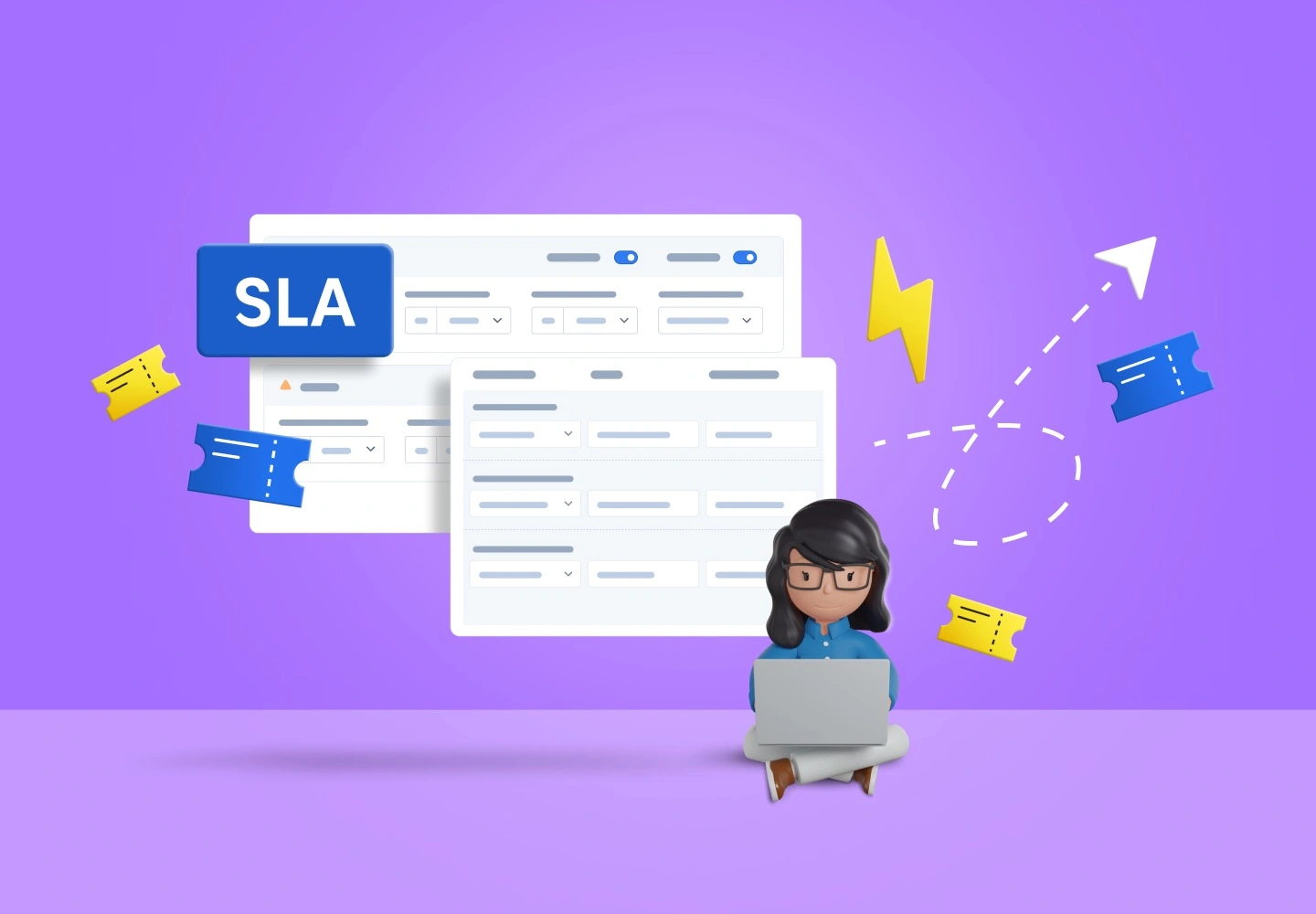Business success depends heavily on an organization’s ability to understand and meet customer expectations. However, managing customer expectations can be complicated when service providers do not provide enough detail about what their customers can expect from them.
To address this, businesses of all sizes use a service-level agreement (SLA).
According to a recent study, 65% of businesses with a tightly aligned service level agreement achieve higher ROI from their inbound marketing efforts.
By reading this blog, you will understand SLAs, their components, and how they benefit productivity.
What is SLA?
A service level agreement is a formalized agreement between a service provider and a client that outlines the expected level of service, including specific metrics and standards to measure productivity and performance.
It provides clarity to situations when problems arise and help set the response and resolution times in support tickets.
SLAs can be configured to operate based on calendar hours (24/7) or specific business hours.
A business can create multiple service level agreements and map them to different support tickets to define the expectations for each SLA metric target.
Obviously, this is an excellent choice for businesses with different tiers of customers who pay for different types of service plans.
For example, you can create unique service-level agreements for customers with free, standard, and enterprise plans.
What are the types of customer service SLAs?
Here’s a breakdown of the types of service level agreements that you can implement depending on the nature of your business:
- Customer-based SLAs: These are service level agreements tailored to meet the specific needs of different customer segments, allowing businesses to offer personalized service levels based on the value or importance of the customer relationship.
- Service-based SLAs: These are SLAs that apply consistent service standards across all customers for specific services. This approach simplifies management and ensures all users have the same level of service.
- Multi-Level SLAs: These service level agreements combine various levels of service commitments, catering to different layers within an organization.
- Internal SLAs: These focus on agreements between internal teams rather than external customers. They ensure that different departments work together seamlessly to provide a cohesive customer experience.
Components of service-level agreements
The components of an SLA depend on both the customer and the service provider. Here are some common components:
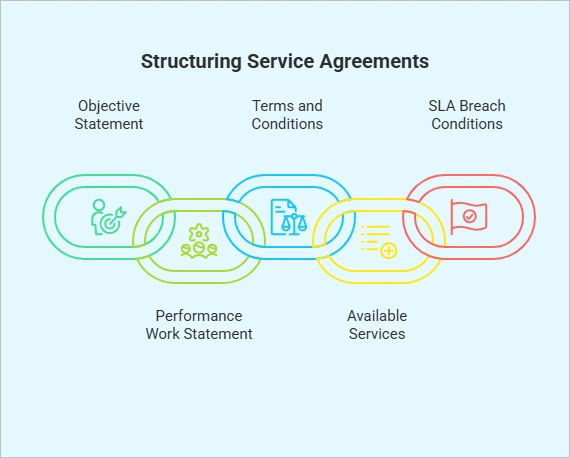
Objective statement
A service-level agreement should state the goals of both the customer support team and the customer. It clearly explains what level of service the customer expects.
The customer support team’s target is to provide consistent, high-quality service while meeting expectations.
Performance work statement
Performance standards state the expected quality of services defined by the customer. They include specific performance or service quality benchmarks.
We should measure the actual service level against these benchmarks to ensure the achievement of the SLA performance standards.
Terms and conditions
Service-level agreements must specify the terms and conditions of the service provided. For example, the customer should know the time period and frequency of service provision.
The terms and conditions should also include the minimum and maximum time allotted to a service provider to respond to a request or resolve an issue.
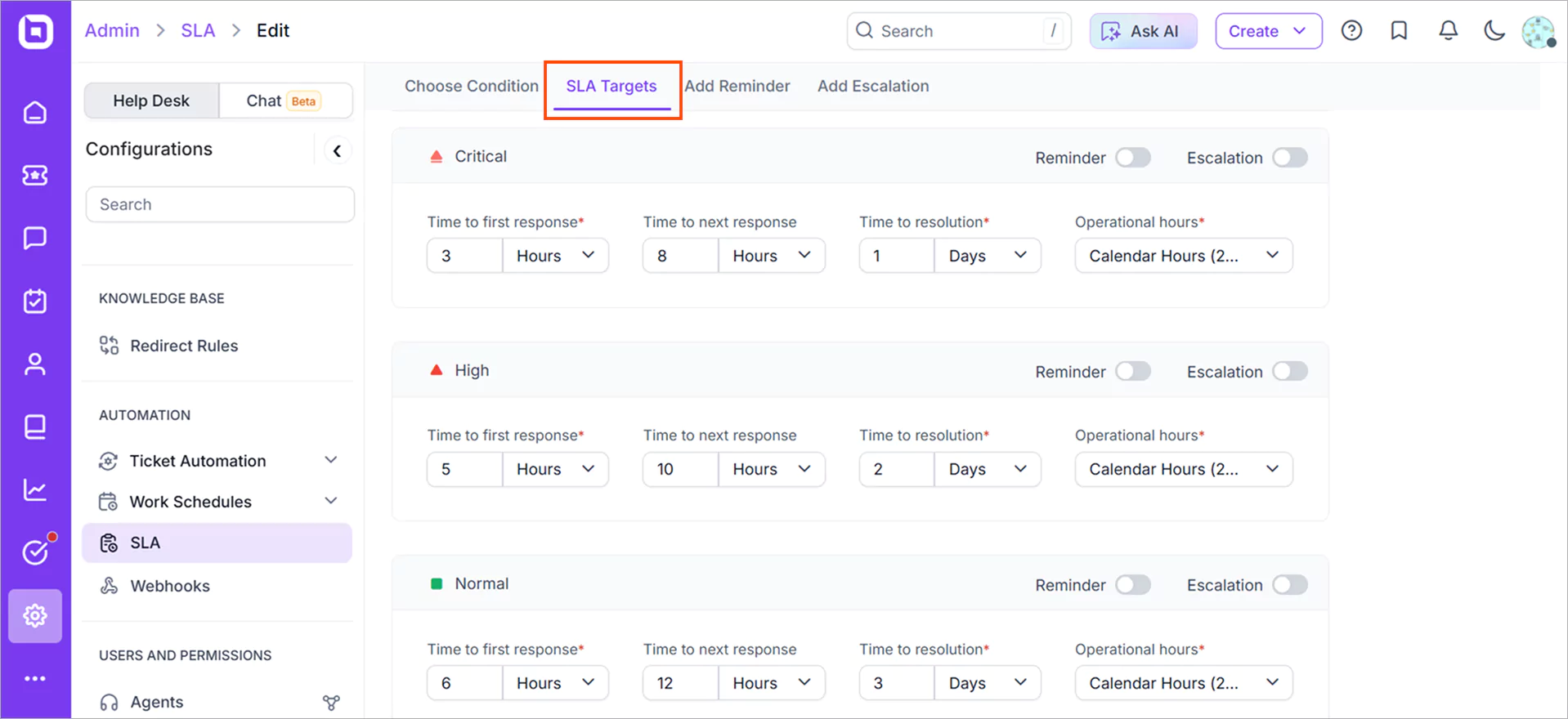
Available services
This section includes information about all the services provided to customers. In addition to the listed services, users may require additional services such as consulting, reporting, and ensuring smooth operations.
As a result, you should include these additional services to create a transparent agreement.
SLA breach conditions
The SLA conditions breach when the service providers don’t complete their tasks within the allotted time. This section states the actions to be taken for the customers.
For example, in the event of a breach, the support agent’s manager could receive a notification about it so that they can take steps to solve similar issues more quickly in the future.
Keep in mind that if the conditions breach frequently, they can affect both parties’ relationships.
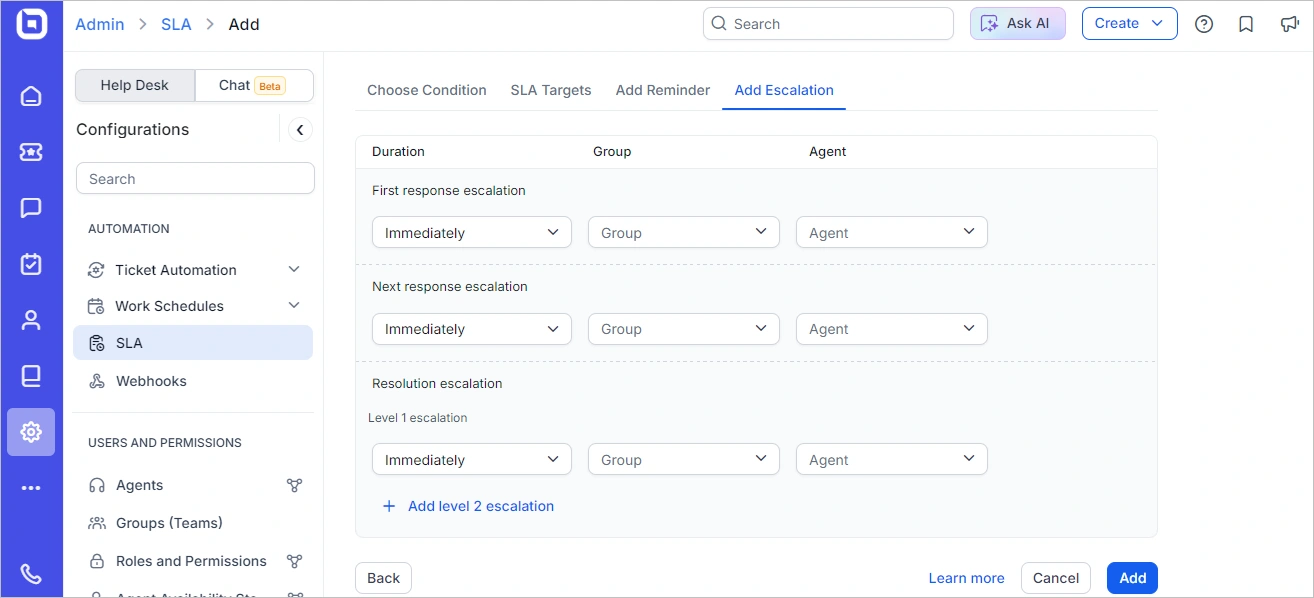
Benefits of using SLA for productivity
An SLA helps improve your organization’s customer service by providing the respective timeline for their work. The service provider works within clearly defined responsibilities and tasks, and the customer receives guaranteed service quality.
Using the agreement in a ticket management system ensures:
- Predictable resources
- Quick issue resolution
- Consecutive customer experience
- Increased productivity
Let’s see some benefits of a help desk service level agreement in brief:
Strengthen relationships between customers and the support team
To ensure long-term success, companies should handle internal and external connections well. A service-level agreement is an incredible tool to establish trust between a company and its customers, ensure quality service, and satisfy customers.
The agreement provides a transparent contract between customers and the support team. When both parties accept it, there will be a lower chance of misunderstanding while service is provided.
A service level agreement is an essential step toward creating a transparent, commonly beneficial, and dependable relationship.
Increases productivity
An SLA ticketing system sets response and resolution times for issues created through tickets. A proper service level agreement will establish priority rules for categorizing issues so the support team can quickly solve the most pressing issues.
With clearly defined priorities and time frames, support team members work more productively and efficiently, allowing them to better meet their SLAs.
As a result, the company is more likely to receive satisfactory help desk service level agreement compliance ratings.
Avoids misunderstandings and conflicts
The agreement provides a reliable information source for avoiding misunderstandings or confusion about what each party needs to do.
Since customers know the details about when to expect their issues to be resolved, there is a mutual understanding between customers and support team members.
Reduces burden on staff
A company can set unique agreements for different customers with different plans. The SLA conditions work based on the calendar or business hours you set to manage the work pressure on staff effectively.
New support agents can easily adapt to the assigned help desk SLA conditions, helping them complete their work in the allotted time.
Helps analyze support team performance
An SLA ticketing system helps track and analyze how many ticket responses (for example, first responses and next responses) and resolutions are provided within the SLA.
From this information, a dashboard provides visualized data of the SLA-achieved tickets against the breached tickets over a time period.
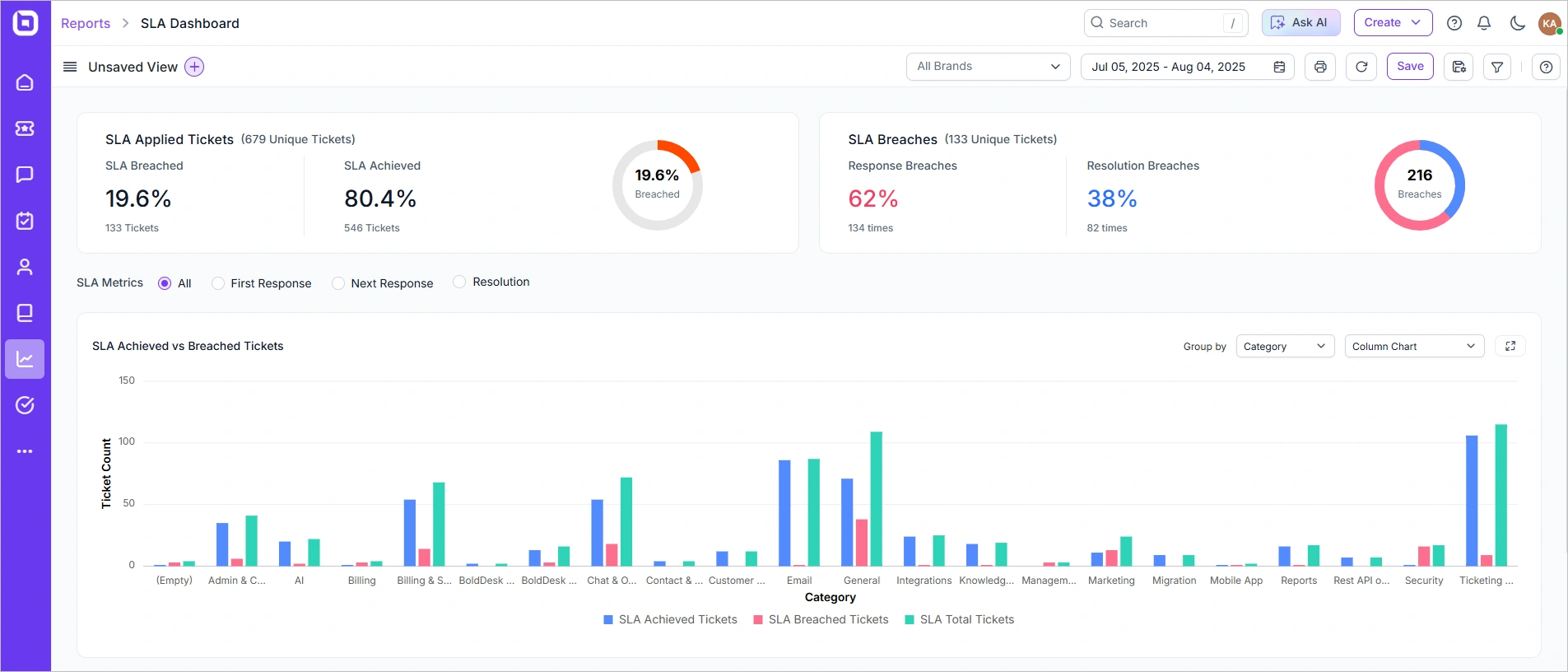
Being able to see this data allows managers to scale their teams’ effectiveness to meet customer expectations.
Helps avoid service failures
When a large number of tickets are received on a daily basis, the support team finds it difficult to keep track of closed and pending tickets.
Service level agreements allow the team to track all KPI parameters that contribute to delayed ticket resolutions, such as the time elapsed for:
- First response.
- Ticket to be assigned to an agent.
- Each response after the first.
- Customers to respond to the support team.
- Tickets need to resolve.
Support teams should set competitive goals for these parameters and receive real-time notifications when a ticket is on the verge of being escalated.
There is no chance of customer dissatisfaction when tickets are resolved well in advance.
Example: A SaaS company tracks metrics like time to first response and resolution time. If a ticket nears escalation, the system alerts the team, allowing proactive resolution and preventing customer dissatisfaction.
Why is SLA necessary for ticket management systems?
Following is an example illustrating the importance of incorporating a service level agreement into your ticket management system.
Imagine that you have just launched a new product, and you start receiving a surge of customer inquiries and technical issues. Without a clear service level agreement in place, your support team might struggle to keep up with these tickets, leading to delayed responses and unresolved issues.
This, in turn, could result in customer dissatisfaction, negative reviews, and potential revenue loss.
By implementing a well-defined service level agreement in your help desk, you can establish clear expectations for:
- Response times
- Resolution times
- Ticket prioritization
- Communication protocols
Setting up your help desk so that notifications are sent whenever SLA-determined deadlines to respond to tickets are nearly reached, for example, keeps those tickets from being overlooked.
Such SLA integration better equips your support team to handle an influx of tickets in an organized and efficient manner, ensuring that no ticket falls through the cracks and customers receive timely updates.
Leverage SLA for productivity and grow your business
An organization that develops and implements a service level agreement improves productivity and smooths customer relationships.
Try using BoldDesk, a comprehensive ticketing management software that enables you to incorporate personalized SLAs.
Contact us to set up a 30-minute live demo to discover how BoldDesk’s features can be customized to accommodate your business’s needs. Sign up for a 15-day free trial today.
Related articles
- 6 Reasons You Need an SLA for Customer Service
- Top 7 SLA Best Practices to Improve Customer Service
- 12 Proven Ways to Improve Agent Productivity
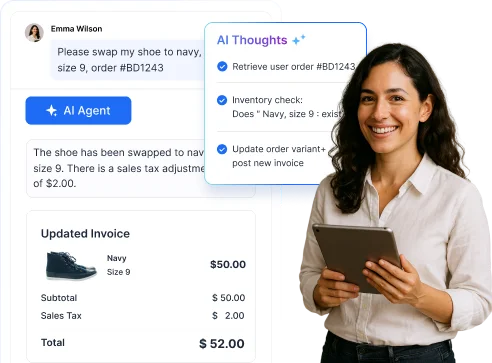


















 Email Ticketing System
Email Ticketing System Shared Inbox Software
Shared Inbox Software Multi Brand Help Desk
Multi Brand Help Desk Internal Help Desk Software
Internal Help Desk Software Trouble Ticketing Software
Trouble Ticketing Software Mobile Help Desk
Mobile Help Desk 









